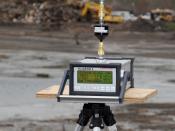OSHA
Have you ever feared for your safety at work, chances are you haven't, but this wasn't the case up until the late sixties? The Nixon administration feared for the workingman especially in the booming of the modern American industrialism. Nixon was concerned that the workingman would be pushed aside and forgot about as machines took over, but he planned to prevent all that from happening with the Occupational Safety and Health Act. The purpose of this act was to prevent the times when the workingman was looked at as a tool that could be thrown around and disregarded as in the early part of the century.
In order to understand the purpose of the Occupational Safety and Health Act, the history of industry in the United States must be examined. Before 1800 there was no industry in the U.S. Many families lived and worked on farms and were self-sufficient.
It was not until the Industrial Revolution when this country began to feel the growth and impact of industry. The biggest change was the transition from manpower to machine power. This led to the creation of the factory, which brought along many hazards to its workers. Any injuries or deaths that occurred as result of the hazards were just figured as part of the process.
Contrary to what some may believe, the government intended on protecting the employer in injury or death of employee situations. There were doctrines of Common law that were the only rules of the industrial community for almost a century. The three doctrines were the Fellow Servant Rule, Contributory Negligence, and the Assumption of Risk. The Fellow Servant Rule stated that the employer was not liable for injury to employee that resulted from negligence of a fellow employee. Contributory Negligence stated that the employer...



Excelent
Very good! I like how complete you are in this paper!
4 out of 4 people found this comment useful.